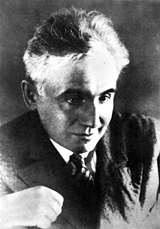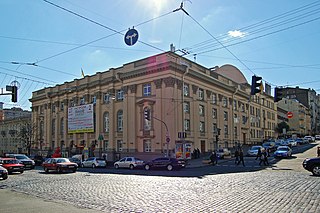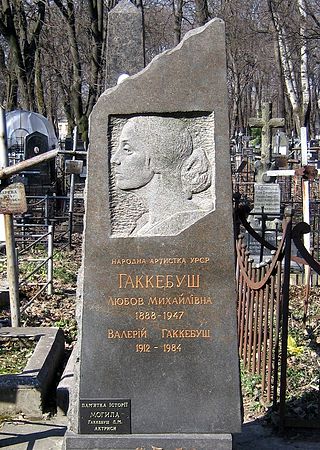
Oleksandr-Zenon Stepanovych Kurbas, was a Ukrainian movie and theater director. He is considered by many to be the most important Ukrainian theater director of the 20th century. He formed, together with Vsevolod Meyerhold, Yevgeny Vakhtangov and several other directors, the Soviet theater avant-garde in the 1920s and 1930s. He is one of the most prominent representatives of Ukrainian avant-garde art. He is considered to be one of the lead figures of the Executed Renaissance. He was murdered by the Soviet regime, during Stalin's Great Terror.

The Solomiya Krushelnytska Lviv State Academic Theatre of Opera and Ballet or Lviv Opera is an opera house located in Lviv, Ukraine largest western city and one of both Polish and Ukrainian historic cultural centres. Originally built on former marshland of the submerged Poltva River, the Lviv Opera now located on Liberty Avenue, the tree-lined centrepiece of Lviv's historic Old City, a UNESCO World Heritage Site located in the city's Halych district.

Solomiya Amvrosiivna Krushelnytska was a Ukrainian lyric-dramatic soprano, considered to be one of the brightest opera stars of the first half of the 20th century.

Lesya Ukrainka National Academic Theater is a theater in Kyiv, Ukraine. It is located in a building known as Bourgogne Theatre.

Maria Zankovetska Theatre is a drama theatre in the centre of Lviv, Ukraine, at the intersection of Lesya Ukrayinka Street and Prospekt Svobody. The building was erected in the mid 19th century and until World War I was used as a theatre stage and a session hall of the regional council.
House of the Halychyna Governorate or Government House is an architectural monument of national significance in Lviv (Ukraine). The building is an example of the Neo-Renaissance style of the Austrian-Hungarian Empire from which the Kingdom of Galicia and Lodomeria was ruled. It was erected in the 1870s to a design by architects Sylwester Hawryszkiewicz and Feliks Księżarski.

The Kyiv National Academic Molodyy Theatre is a theatre in Kyiv in Ukraine. It was founded in 1979 and first played on 26 April 1980, with a focus on progressive productions. It is also known simply as Molodyy Theatre, and addresses people "young in mind". It is a member of the European Theatre Convention, and became a national institution in 2019.

Theater in Ukraine is a form of fine arts and cultural expression using live actor's performance in front of spectators. Ukrainian theater draws on the native traditions, language and culture of Ukraine. The first known records of Ukrainian theater trace back to the early 17th century.

Hnat Petrovych Yura was a Soviet and Ukrainian director, actor of theatre and film, pedagogue. He directed two films, and appeared on screen six times during the Soviet era. Yura received titles of professor (1946), People's Actor of Ukraine (1930), and People's Actor of the Soviet Union (1940).

Eugene Lavrenchuk is a Ukrainian opera and drama director, producer and teacher. Director, co-founder (2002), and artistic director of the Polish Theatre in Moscow (2002–2014) and the School of acting and directing. Chief director of the Odesa National Opera House (2018–2021). Rector of the First Ukrainian School of Theater and Cinema (2018), Founder and Head of the Expert Council of the All-Ukrainian Opera Forum. Has staged more than 30 plays (performances-list). Makes productions and also carries out active teaching work in Ukraine, Poland, Germany, Lithuania and Israel. The author of the methodology of teaching acting skills and directing. Merited Artist of Ukraine (2021).

The Kharkiv Ukrainian Drama Theatre also known as the Taras Shevchenko Kharkiv Academic Ukrainian Drama Theatre is a national theatre founded in 1935 out of remnants of the suppressed Berezil Theatre, which was founded by Les Kurbas in 1922. Kharkiv Ukrainian Drama Theatre has two stages: Main Stage and Small Stage "Berezil".

The Grand Hotel is a hotel located in Lviv, Ukraine. It was opened in 1894 and has most recently been reconstructed between 2014 and 2018.

The Ukrainska Besida Theatre – was the first Ukrainian professional theatre in operation from 1864 to 1924. Its first performance took place in the premises of The Ukrainian National Home building in Lviv. The theatre was subsidized by the Ruska Besida Society in Lviv and occasionally supported by the Galician Diet.

The Lviv Organ Hall is a concert hall located within the Church of St. Mary Magdaline in the city of Lviv, constructed in the 17th century. It is home to one of the largest organs in Ukraine, and hosts concerts of organ, symphonic, and chamber music. It is roughly 800 square meters and size and can hold up to 350 people, hosting roughly thirty performances each month.

Olimpia Ostapivna Dobrovolska was a Ukrainian theater actress, play director, theater teacher and theorist of Ukrainian art of the 20th century. She was a wife of an actor Yosyp Hirniak.

Liubov Mykhailivna Hakkebush was a Ukrainian stage actress, teacher, and translator. People's Artist of the Ukrainian SSR (1943). She appeared in over 80 leading and supporting roles, including the most well-known roles of Lady Macbeth in William Shakespeare’s Macbeth and Fru Alving in Ibsen's Ghosts.
Maksym Heorhiyovych Holenko is a Ukrainian director of theater and cinema, chief director of the independent "Wild Theater," and chief director of the Odessa Academic Ukrainian Music and Drama Theater named after Vasyl Vasylko.

Building of the Chernihiv Regional Youth Center, formerly Shchors cinema was a building in Chernihiv, Ukraine. The building is an architectural monument of local significance in Chernihiv. A former cinema, the building has housed the Chernihiv Regional Youth Center since 2017.
International Competition of Young Vocalists named after Vasyl Slipak is a competition in honor of Vasyl Slipak, a Ukrainian opera singer who was a soloist of the Paris National Opera, a participant in the War in Donbas and Hero of Ukraine. The competition is held in Lviv. The first competition was held in 2017 from December 15 to December 20 at the Lviv Regional Philharmonic. There are four categories in two age groups: students of educational institutions I and II levels of accreditation up to 22 years old, including two rounds, and students of educational institutions III and IV levels of accreditation up to 30 years old, including three rounds. The competition program is defined by the Competition Regulations. President of Ukraine Volodymyr Zelensky signed an order to support the competition.
















